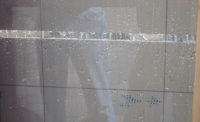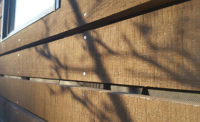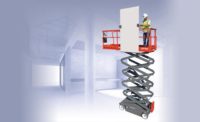Maintaining a building’s useful life calls for periodic exterior renovation. Determining the most appropriate course for restoring a building’s facade requires careful deliberation. No matter
what the condition of a building’s exterior, there are solutions to help you restore the value of your investment. From simple maintenance to complete façade restoration, four levels of restoration can extend that building’s life, improve its performance and enhance its curb appeal.
Level 1 - Clean & Recoat
Airborne grime, splash-up from roadways and pedestrian traffic – buildings get dirty, especially in urban areas. When they are soiled, they look old and neglected; it’s not the image that building owners or tenants want to project. The good news is, if a building’s water-shedding surface is basically sound, surface-level cleaning can remove dirt, mold and mildew; combined with recoating- this two-step refresh will extend the life cycle of the façade. Update the color at the same time and you will have put a completely new face on what was an old and tired façade.
A standard clean-and-recoat process usually involves a thorough pressure washing and surface finishing with a high-performance coating. Coatings today can deliver far more than paint; they can resist accumulation of dirt, mold and pollutants and can improve resistance to water, cracks and fading. These relatively simple steps can preserve a building’s value while enhancing its appearance and reducing maintenance needs.
A regular program of cleaning and repair will not only refresh a building’s appearance and mitigate the effects of normal wear and tear over time, but it will help to prevent potential problems such as moisture intrusion from developing.
Level 2 - Repair & Refinish
This level of restoration is designed to keep minor damage to EIFS, stucco or concrete facades from becoming a major problem. When small areas of wear develop, they should be repaired as soon as possible so they don’t turn into significant damage that’s much more difficult and expensive to remedy.
Surface deterioration, patches and superficial cracking can add up to a dull or shabby look, especially on stucco walls. Surface repairs and an updated finish, in combination with regular maintenance, can improve curb appeal dramatically and will extend the life cycle of the cladding.
Repairs for cracking and other damage are always substrate-specific so it’s difficult to generalize, but often an additional layer of basecoat with embedded mesh is used to restore the building exterior to its original condition. Refreshing the outer lamina with basecoat, mesh and new finish allows one to hide all the underlying repairs and create a “like new” surface to the building. Patching and repairs should never look like painted patches and repairs. After the damage is repaired, a high-performance finish can be applied to seal the surface, protecting it from the elements and slowing down the natural wear and tear.
There are many high-tech refinishing products on the market today that will safeguard an exterior from wind-driven rain, ultraviolet rays, mold and mildew. Stolit Lotusan is one product with a patented micro-textured surface that beads water—self-cleaning a wall by washing away dirt with rainfall.
Level 3 - Overclad
Overcladding is a more extensive, but often more cost-effective restoration solution to address moisture intrusion. It also may be part of an energy retrofit and upgrade to improve occupancy comfort, while also updating an older building’s aesthetic appeal. This level of restoration is typically triggered by rising maintenance costs related to the age of the structure. Energy costs also tend to rise as a building envelope gets older. Mechanical systems may be obsolete and vintage buildings that haven’t been restored typically lack curb appeal. Installing a new insulated wall cladding over existing brick, block or stucco gives a fresh, new look to an older building, while significantly increasing its thermal heating and cooling efficiency.
Overcladding restorations and retrofits are excellent ways to extend a building’s life cycle in a way that can be far less expensive than rebuilding. Look for a state-of-the-art, energy-efficient insulated wall cladding system that will remain aesthetically pleasing for years, while improving indoor air quality and lowering overall lifecycle costs. Overcladding can usually be performed while the tenants still occupy the building, which puts less organizational stress on the owner for this type of project.
Level 4 - Remove & Reclad
When extensive renovation and restoration are required, it is often most efficient and practical to start over with new cladding. Replacing a façade can also be a cost-effective way to upgrade the building to meet current building code requirements. When the cladding, substrate or sheathing and supporting structure have incurred significant damage, it warrants replacement; likewise, if the control layers are damaged, not connected correctly or not properly installed. Water intrusion and subsequent damage may have caused structural risks, such as a cladding failure and health concerns such as mold.
The Perfect Wall
Before addressing specific conditions, claddings and restoration solutions, let’s review the optimum wall: There are five planes of control for the ideal building envelope that need to be properly connected and integrated with other building elements. The understandings of these control layers and their importance has only come about in the last decade. Unfortunately, there are thousands of buildings where the control layers are already established. In these older structures, some control layers are connected and working properly and some are not. Advancements in hygrothermal modeling in recent years has allowed us to better understand the impact of these control layers on how we build and repair our existing structures for the next century and beyond. All restorations should be started with an understanding of the ways each of these layers may be affected.
- Vapor Retarder: To control the flow of water vapor from areas of high to low pressure, minimizing condensation.
- Air Barrier: To limit the uncontrolled flow of air through the wall assembly, reducing condensation and energy loss.
- Water Penetration Barrier: Barrier inbound of the cladding, flashed to the exterior, designed and installed to prevent liquid water from entering the wall cavity.
- Effective Thermal Barrier: Insulation to significantly reduce thermal bridging.
- Water Shedding Surface: Coupled with flashing to protect and divert water away from the wall.
Exterior restoration techniques differ for each cladding and will depend on what level of restoration is required. You should consult with building science professionals who have knowledge of claddings and can conduct a complete cladding and envelope inspection. If a level 3 or level 4-type restoration is necessary, a third-party building envelope professional should be retained to evaluate conditions and make recommendations.
While much can be written about what to look for in assessing the appropriate restoration level and which solutions suit different surfaces, the following are some of the more common restoration issues and guidance for determining the best course of action.
EIFS Restoration
When damage does not include breaks in the mesh or insulation, regular exterior insulation finishing system, more commonly known as EIFS, maintenance or recoating can eliminate the damage and restore integrity to the water-shedding surface. Cleaning the wall, removing dirt, mildew and mold, checking and repairing sealants and simply recoating with low maintenance coatings or new color will suffice.
If there is damage in the field of an EIFS wall—when an EIFS with standard mesh is punctured or cracked - the barrier system is vulnerable to water intrusion and will require Level 2 repairs. When a damaged EIFS is cut away for repair, the underlying substrate can be examined; if there is no evidence of water penetration or impact damage to these layers, the repair and recoating can proceed. If there is water penetration in the wall assembly or impact damage, the damaged substrate will require installation of new insulation, base coat, mesh and finish to restore the integrity of the EIFS system.
A common EIFS restoration issue is inadequate separation between roofing and the EIFS. Traditional EIFS detailing prescribes that the system terminate approximately two inches above finished roofing. This clearance allows re-roofing to take place without damaging the EIFS. In addition, the clearance allows for leaves and other natural debris to be cleared by wind or regular maintenance, preventing the moisture retained in the debris from staining and deteriorating the finish. This separation is often missing.
As part of a Level 2 restoration, the EIFS should be modified in compliance with industry recommendations. This repair may be undertaken as part of regular EIFS maintenance, as preparation for reroofing or as a restoration of the finish. The EIFS termination can be cut away and refinished while incorporating the required separation above the roofing. Repairs may require incorporating roof step flashing into the waterproof air barrier behind the EIFS; modifications to the diverter flashing at the bottom of the slope may also be required.
Other EIFS issues that may require restoration include damaged EIFS corners, incorrectly installed and decks that are attached without flashing. Sealant repair, replacement or installation of new joints may be necessary.
When extensive EIFS renovation and restoration is required and if you’re looking to do a serious energy retrofit, the existing wall cladding can be overclad or replaced which is Level 3 and 4 restoration. Installing a continuous insulation system or prefabricated panel installation with an envelope design engineered to integrate all planes of control in the wall—air, vapor, thermal, moisture penetration control and surface water shedding—is well worth the investment. For the most energy efficient upgrade, removing and recladding, vs. overcladding is usually the preferred procedure and it is usually recommended.
Restoring Stucco
Cracked and deteriorated caps over a masonry wall; straight, vertical or horizontal cracks, decorative profiles that are stained and damaged by collecting dirt, retaining snow and rain water, stucco de-bonding from concrete substrate—these conditions are all candidates for various levels of restoration.
If hairline cracks are few and minor, an elastomeric coating may be sufficient. Check and repair sealants as well as joint intersections to ensure they remain watertight. As part of basic Level 1 restoration, one should also conduct a thorough cladding and envelope inspection so one can correct deteriorating conditions before they become problematic.
Overcladding is very common and often recommended on stucco, masonry and concrete when Level 3 repairs are required. The following are some specific restoration issues associated with stucco.
Horizontal and vertical reglet interfaces often deteriorate in stucco. Metal one-piece reglets can be used as decorative elements within a 144 square foot stucco panel. However, one-piece reglets have no movement capability and have not been designed for the degree of stress movement expected when calculating panel size. If used for this function, cracking will occur at the stucco/reglet interface. In addition, these metals, such as anodized aluminum or galvanized steel, are vulnerable to corrosion, especially in coastal environments, if the protective coating is damaged.
To correct this, as part of a Level 3 restoration and to protect the stucco from further deterioration around the reglets, installing a continuous insulation overclad will avoid removal and replacement of the reglet while extending the life cycle of the cladding assembly. The proper continuous insulation system will also enhance the wall’s thermal control by reducing thermal bridging and air leakage.
Stained or damaged decorative profile - Profiles added to stucco walls often have flat horizontal ledges that collect dirt and retain snow and rainwater. The acrylic finish on this ledge will soften and deteriorate if it retains standing water. Where dirt accumulates on the ledge, water run-off will carry the dirt onto the profile and create streaks down the face of the wall. This problem only requires a Level 2 aesthetic upgrade and restoration of the water-shedding surface of the wall. No stucco modifications or profile replacements are necessary.
After cleaning the wall and removing any loose finish, a simple foam wedge can be added to the top edge of the profile and incorporated into the new finish. If the profile is damaged or its bond to the stucco is compromised, the profile may require removal and replacement. Even the small profiles that follow this wedge detail will need encapsulation of a new mesh base and finish. If the profile is large and unprotected, extending out from the stucco more than 4 inches, a water-resistant base coat or a metal flashing may be required to improve long-term durability.
Straight, vertical or horizontal cracks: A straight crack through stucco typically indicates stress relief. Often the crack, vertical or horizontal, signals that a functional joint should have been installed at that location. If not repaired, the stucco will continue to deteriorate, creating an enlarged path for water intrusion. A Level 2 restoration is required to preserve the integrity of the water-shedding surface. If the repair is made promptly, damage from water penetration will be minor, avoiding deterioration of the lath, mechanical connections or water resistive barrier. It is likely that a functional joint will be required. The joint, which will run the full height or width of the stucco panel, may be installed as a stand-alone repair or as part of a complete facade restoration.
Restoring Concrete, CMU, & Masonry
While sandblasting or other methods of creating a clean surface may be required, basic cleaning and recoating with a vapor permeable product is sufficient for basic Level 1 concrete restoration. A field adhesion test should always be performed when coating an existing surface and will validate the engineers desired adhesion values.
Staining at the parapet cap mortar joint and signs of rust or spalling may indicate deteriorated rebar and require a Level 2 restore.
If the concrete substrate is clean and sound, it may be overclad with a adhesively applied EIFS system. If it isn’t suitable for bonding in this manner because of existing coatings or concrete additives, a steel lath can be applied to the substrate, suitable for adhesive attachment, or Ventec systems or lightweight panel maybe installed. A structural engineer should evaluate any planned overcladding of an existing structure.
Since uninsulated concrete provides poor thermal performance, recladding with an EIFS system can improve energy efficiency, with continuous insulation providing solid connection for all envelope control layers previously referenced—vapor barrier, waterproof air barrier, thermal barrier and water shedding surface.
There are many industry resource guides for wall restoration, including Sto’s new “Restoration of Building Facades” booklet, which can be accessed at www.stocorp.com/restore-us/
Don’t Ignore It. Restore it.
In addition to protecting the value of your investment, there is tremendous economic and environmental value in restoring building exteriors. In fact, an investment in restoration, together with improved thermal efficiency, is quite favorable compared to the costs associated with demolition and rebuilding.
Even a basic restoration that includes color changes can re-brand and revitalize a structure. Innovative new coatings are now available to improve and protect a building’s exterior and reduce maintenance costs. With Level 2 restoration, the life cycle of the building envelope is further extended, forestalling future problems, e.g. sloped surface deterioration, flashing replacement, and damage that could lead to water penetration.
With reduced operating costs, improved curb appeal and extending the building’s life cycle, property values increase. It’s a win-win on many fronts.
Restoration Market Opportunity
According to the Organization for Economic Co-Operation and Development, the existing building inventory in the United States and Canada represents approximately 119 million households and over 80 billion square feet of commercial building space. A substantial portion of this commercial floor space was built prior to 1980 and a substantial number of the buildings that were built in the first half of the 20th century are still in operation and consuming energy.
Rising energy costs, growing concerns about greenhouse gas emissions, as well as a new mandate from the International Energy Conservation Code to expand the use and increase the minimal thickness requirement for continuous insulation for all wall assemblies in nearly all climate zones have created a great momentum for the restoration and retrofitting of aging buildings.
The market research and consulting firm Navigant Research, formerly known as Pike Research LLC, projects that by 2020, the market demand for retrofitted solutions for commercial buildings will reach $152 billion US dollars worldwide.










Report Abusive Comment